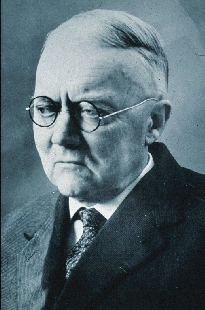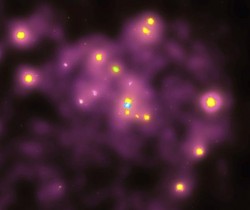http://www.universetoday.com/33475/messier-31/ wrote:
Messier 31
by Tammy Plotner< Universe Today, June 25, 2009
Object Name: Messier 31
Alternative Designations: M31, NGC 224, Andromeda Galaxy
Object Type: Type Sb Galaxy
Distance:
2900 (kly)
Visual Brightness: 3.4 (mag)
<<
“We present the first detailed spectroscopic and photometric analysis of an eclipsing binary in the Andromeda Galaxy (M31). This is a 19.3 mag semidetached system with late O and early B spectral type components.” says Ignasi Ribas (et al), “From the light and radial velocity curves we have carried out an accurate determination of the masses and radii of the components. Their effective temperatures have been estimated by modeling the absorption-line spectra. The analysis yields an essentially complete picture of the properties of the system, and hence an accurate distance determination to M31.”
Approaching us at roughly 300 kilometers per second, our massive galactic neighbor has been the object of studies of spiral structure, globular and open clusters, interstellar matter, planetary nebulae, supernova remnants, galactic nucleus, companion galaxies, and more for as long as we’ve been peering its way with a telescope. It’s part of our Local Group of galaxies and its two easily visible companions are only part of the eleven others that swarm around it. One day we’ll join forces, much as it M31 is now consuming its neighbor – M32 – but not for many millions of years yet!
How many times has the Great Andromeda Galaxy consumed another? More than once. In 1993 the Hubble Space Telescope revealed that M31 has a double nucleus – a ‘leftover’ from another meal! “Each of the two light-peaks contains a few million densely packed stars. The brighter object is the “classic” nucleus as studied from the ground. However, HST reveals that the true center of the galaxy is really the dimmer component. One possible explanation is that the brighter cluster is the leftover remnant of a galaxy cannibalized by M31.
Another idea is that the true center of the galaxy has been divided in two by deep dust absorption across the middle, creating the illusion of two peaks.
Perhaps one of the most fascinating discovery recent years in Messier 31 was made by the orbiting Chandra X-Ray Observatory. This X-ray image, made with the Chandra X-Ray Astronomy Center’s Advanced CCD Imaging Spectrometer (ACIS), shows the central portion of the Andromeda Galaxy. The blue dot in the center of the image is a “cool” million degree X-ray source where Andromeda’s massive central object, with the mass of 30 million suns, is located, which many astronomers consider to be a supermassive black hole. Most of these are probably due to X-ray binary systems, in which a neutron star (or perhaps a stellar black hole) is in a close orbit around a normal star.”
In 2005, we discovered more. From the Astrophysical Journal: “Scott Chapman of the California Institute of Technology, Rodrigo Ibata of the Observatoire de Strasbourg, and their colleagues report that their detailed studies of the motions and metals of nearly 10,000 stars in Andromeda show that the galaxy’s stellar halo is “metal-poor.” In astronomical parlance, this means that the stars lying in the outer bounds of the galaxy are pretty much lacking in all the elements heavier than hydrogen. This is surprising, says Chapman, because one of the key differences thought to exist between Andromeda and the Milky Way was that the former’s stellar halo was metal-rich and the latter’s was metal-poor.
If both galaxies are metal-poor, then they must have had very similar evolutions.” Probably, both galaxies got started within a half billion years of the Big Bang, and over the next three to four billion years, both were building up in the same way by protogalactic fragments containing smaller groups of stars falling into the two dark-matter haloes,” Chapman explains. Galaxies like Andromeda and the Milky Way have each probably gobbled up about 200 smaller galaxies and protogalactic fragments over the last 12 billion years. The stars that dominate closer to the center of the galaxy, by contrast, are those that formed and merged later, and contain heavier elements due to stellar evolution processes. In addition to being metal-poor, the stars of the halo follow random orbits and are not in rotation. By contrast, the stars of Andromeda’s visible disk are rotating at speeds upwards of 200 kilometers per second.According to Ibata, the study could lead to new insights on the nature of dark matter. “This is the first time we’ve been able to obtain a panoramic view of the motions of stars in the halo of a galaxy,” says Ibata. “These stars allow us to weigh the dark matter, and determine how it decreases with distance.”
........................................................................................
History: Known as the “Little Cloud” to to the Persian astronomer Abd-al-Rahman Al-Sufi, who described and depicted it in 964 AD in his Book of Fixed Stars, this wonderful galaxy was also cataloged by Giovanni Batista Hodierna in 1654, Edmund Halley in 1716, by Bullialdus 1664, and again by Charles Messier who wrote in his notes: “
The sky has been very good in the night of August 3 to 4, 1764; and the constellation Andromeda was near the Meridian, I have examined with attention the beautiful nebula in the girdle of Andromeda, which was discovered in 1612 by Simon Marius, and which has been observed since with great care by different astronomers, and at last by M. le Gentil who has given a very ample and detailed description in the volume of the Memoirs of the Academy for 1759, page 453, with a drawing of its appearance. I will not report here what I have written in my Journal: I have employed different instruments for examining that nebula, and above all an excellent Gregorian telescope of 30 pouces [French inch ~ 27mm] focal length, the large mirror having 6 pouces in diameter, and magnifying 104 times these objects: the middle of that nebula appeared rather bright with this instrument, without any appearance of stars; the light went diminishing up to extinguishing; it resembles two cones or pyramids of light, opposed at their bases, of which the axis was in the direction form North-West to South-East; the two points of light or the two summits are about 40 minutes of arc apart; I say about, because of the difficulty to recognize these two extremities. The common base of the two pyramids is 15 minutes: these measures have been made with a Newtonian telescope of 4 feet and a half focal length, equipped with a micrometer of silk wires. With the same instrument I have compared the middle of the summits of the two cones of light with the star Gamma Andromedae of fourth magnitude which is very near to it, and little distant from its parallel. From these observations, I have concluded the right ascension of the middle of this nebula as 7d 26′ 32″, and its declination as 39d 9′ 32″ north. Since fifteen years during which I viewed and observed this nebula, I have not noticed any change in its appearances; having always perceived it in the same shape.”
Sir William Herschel knew way ahead of everyone else, that there was something very, very different about Messier’s Object 31! Although he never publicly published his observing notes on another astronomer’s discoveries, it’s a shame he did not for this is what he had to say: “
.. But when an object is of such a construction, or at such a distance from us, that the highest power of penetration, which hitherto has been applied to it, leaves it undetermined whether it belongs to the class of nebulae or of stars, it may be called ambiguous. As there is, however, a considerable difference in the ambiguity of such objects, I have arranged 71 of them into the following four collections. The first contains seven objects that may be supposed to consist of stars, but where the observations hitherto made, of either their appearance or form, leave it undecided into which class they should be placed. Connoiss. 31 [M31] is: A large nucleus with very extensive nebulous branches, but the nucleus is very gradually joined to them. The stars which are scattered over it appear to be behind it, and seem to lose part of their lustre in the passage of their light through the nebulosity; there are not more of them scattered over the immediate neighborhood. I examined it in the meridian with a mirror of 24 inches in diameter, and saw it in high perfection; but its nature remains mysterious. Its light, instead of appearing resolvable with this aperture, seemed to be more milky. The objects in this collection must at present remain ambiguous.”>>
 M31: The Andromeda Galaxy
M31: The Andromeda Galaxy





